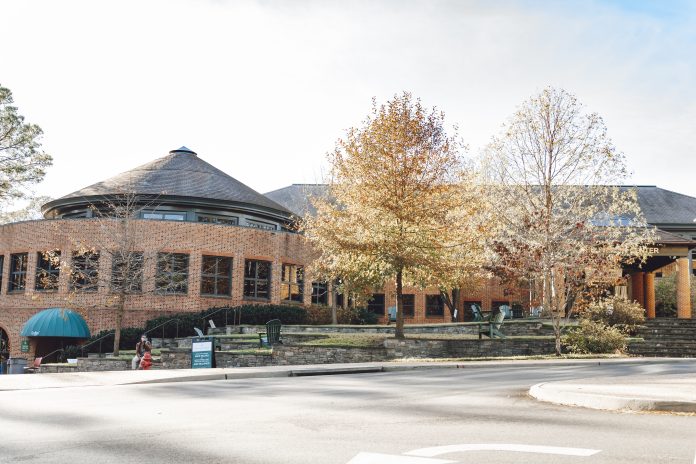Friday, Feb. 23, a sea of zebras and stuffing floated around Sadler’s Lodge One, where dozens of students lined up to make their very own stuffed animal. Alma Mater Productions and Students for Rare collaborated on this plushie-filled event in honor of upcoming Rare Disease Awareness Day.
AMP and Students for Rare gave students the opportunity to make zebra plushies, given that this animal is the symbol of the rare disease community. There is a saying within the medical community that “when you hear hoofbeats, think of horses, not zebras,” encouraging the diagnosis of common conditions before searching for rare ones. Therefore, people affected by rare diseases are often misdiagnosed until it is eventually discovered that they could be suffering from a rare condition instead, also known as the zebra.
Chair of the AMP Impact Committee Quinn Loftus ’24, who worked alongside her fellow committee member Sage Futrell ’26 to come up with this event, discussed the reasoning behind the stuffed animals chosen.
“Sage really wanted an event that focused on rare diseases but that was still applicable to the public,” Loftus said. “So we made a zebra stuffed animal making event with some other stuffed animals mixed in just to have some variety and also to show not everybody connects with the zebra personally, but they’re still an ally to the Rare Disease group.”
Loftus related the creation of this event to the close connection one of her committee members had with the Students for Rare cause.
“I have a committee member who’s a part of Students for Rare, has a rare disease and cares a lot about this,” Loftus said. “Everyone in my committee has different groups that they feel strongly about, different political issues they feel strongly connected to. So my goal is to make sure that my committee members feel like they can speak on behalf of those groups, and we try to reach out to as many groups as we can in a year.”
A long winding table was set up with different stations for students to pass through in the plushie-making process. First, students would select their animal of choice, then they would receive some stuffing and could complete the activity by dressing their toy in a customized “I care for Rare” T-shirt. Other decorative ribbons and pins with several references to the rare disease cause were also dispersed across the table.
Meanwhile, in a panel discussion on the main stage, three members of Students for Rare — Internal Co-President Cate Jones ’25, External Co-President Allison Stovall ’25 and Secretary Mariana VanPelt ’26 — shared their experiences living with a rare disease. They all expressed appreciation for the big event turnout and for the large number of students who carefully listened to their stories.
“I thought a plushie was definitely helpful for generating turnout,” Jones said. “Getting free stuffed animals is going to get people to come, and I was really excited to see the number of people who genuinely did stay to listen. I was hoping people would, but you never know.”
Jones expressed the importance of having other students listen closely to the stories of people affected by disability and rare diseases to increase education and awareness around these overlooked topics. VanPelt shared a similar sentiment when reflecting on the best ways in which students outside this particular community can better become allies for it.
“For students, I think especially as a fellow bio major, you just have to be cognizant of things you’re learning and how they’re applied and be careful of biases,” VanPelt said. “I think it’s very important to, instead of speaking over other people, uplift other people’s voices who are talking about their experiences with things.”
This event represented an opportunity for a broader student audience that is largely unaffected and, in some cases, unaware of rare diseases to reflect on these important issues. Loftus discussed how this aspect fit into her vision and goals for this event.
“The goal is to have really meaningful events, but also a significant turnout because we’re an event planning organization,” Loftus said. “We want to have people come out to our events. We want them to be worthwhile. For this event, it was about making it reach the public.”
With the greater audience came initial anxiety for some participants. Stovall reflected on how this event helped her overcome the uneasiness of speaking about her personal experience onstage in front of a large audience.
“I’ve been super excited about it since Sage proposed the idea,” Stovall said. “Coming into it knowing I was going to speak in front of people, I was a little bit nervous, just because I’ve never spoken about my experience on this type of scale before, but I’m so happy with how it turned out. I’m so glad we got a bunch of people.”
For students interested in learning more about and raising awareness for rare diseases, Students for Rare also hosted a bake sale Feb. 28 to celebrate this year’s annual Rare Disease Day, featuring zebra cakes to represent the community.


[…] AMP and Students for Rare gave students the opportunity to make zebra plushies, given that this animal is the symbol of the rare disease community. There is a saying within the medical community that “when you hear hoofbeats, think of horses, not zebras,” encouraging the diagnosis of common conditions before searching for rare ones. Therefore, people affected by rare diseases are often misdiagnosed until it is eventually discovered that they could be suffering from a rare condition instead, also known as the zebra. Read more… […]